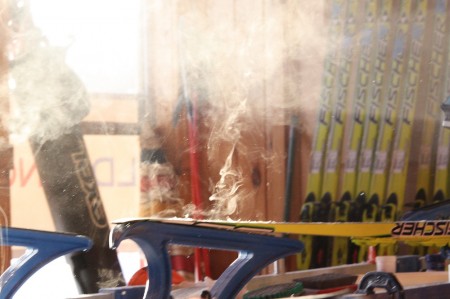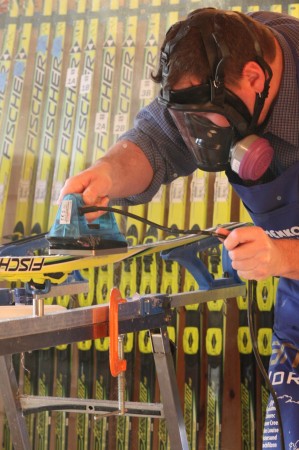Roger manages Boulder Nordic Sport’s Portland, Maine, store as well as national team and wax sales. In addition to being one of North America’s premier wax techs he publishes articles and regular wax recommendations on bouldernordicsport.com. A version of this article also appeared in a recent BNS newsletter.

Very little has been written or talked about in terms of wax safety in recent years. It is definitely the proverbial “elephant in the room” that is often not discussed when we talk about the nuances and tricks of waxing. The reality is that we should all be subscribing to the “safer is better” strategy. This means not only well ventilated wax areas, not over heating wax or exposing it to open flame, but also wearing face protection. Not just any face protection, but proper protection. We, as skiers and parents and wax techs, are not being smart about this and we need to start being cautious and safer.
When discussing wax safety, there are a couple of things that need to be addressed. The most obvious and easiest to deal with is using a proper iron and following the temperature instructions on the wax packaging. A proper iron means that it is made by a wax or tool company so it has Celsius or Fahrenheit temperatures on it. This allows you to match up the correct setting with the manufacturer’s recommendation on their packaging. It is important to note that a Proctor Silex dry iron from your local department store is not a safe solution. These irons can vary massively in temperature on one setting creating dangerous conditions for you and your ski base.

An important step in waxing safety is to not expose any glide waxes to open flame. While there are varying degrees of flammability among the different types of gliders, there simply is no reason to ever expose them. A pure fluorocarbon, for example, can turn into a noxious gas when exposed to open flame–it goes without saying that this is not ideal. Torches and heat guns should be used on kick wax and klister only. Even then, you need to use caution with these forms of open flame, especially near the exterior of the kick area near the glide zones.
Most people have the basics of these first two down, but are you protecting your face as much as you should be? Walking around at races, I see people using some form of respirator when applying pure fluorocarbons or when ironing in HF waxes. What is not as common however is wearing a mask when using an iron on LF or CH waxes, scraping, or brushing. Let’s address each of these issues one at a time.
Wearing a mask when using LF or CH waxes: The bottom line is that if you are going to wear a mask because you are worried about the smoke from waxes, you should be wearing it for all waxes. While there might be more risk with a pure fluoro, smoke and fumes are present always. Thus wearing a mask all the time should be your call. Err on the cautious side and just do it.
Wearing a mask when scraping and brushing: This is where I see major problems. Think of what you are doing when scraping and brushing–creating particulates that go into the air. Your face is hovering above the ski and you are inhaling this particulate. Period. It does not matter how great the ventilation is, you will be inhaling this through your mouth and nose. In addition to this, your eyes are most likely not covered which is another access and irritation point. Inhaling particulate of any variety is, in my opinion, not a smart move. Will it kill you? Probably not, but it could lead to short term irritation of lungs, throat and eyes. It could also lead to long term health consequences, though nothing has ever been proven on this subject conclusively. I personally do not need conclusive evidence; I would rather protect myself now and not have to worry about this later.

What is the best way to protect yourself? Get the proper respirator with the proper cartridge filters. Ideally, what you are looking for is a full-face respirator that covers your eyes, nose and mouth. Many people use the half-face models that cover nose and mouth; this is better than nothing. However, this leaves out eye protection and the half-face models tend to not fit snugly enough to completely seal the nose/mouth area off. This is why investing in a nice full-face respirator makes sense for anyone who is spending much time working on skis. For cartridges (filters), I highly recommend P100 cartridges. These are the industry standard for waxing and give full protection against all particulates and organic vapors that waxing can produce. I have been wearing a 3M Sperian full face respirator with these hard P100 cartridges for three years now and have never felt safer. Not many people have the opportunity to wax skis for six hours straight at events like US Nationals, but I do. The Sperian mask has been a dream with comfort, not fogging and never interfering with the most important thing: waxing the ski to perfection.
I suggest you invest in one today, after all we only get one shot at this thing called life, why not be safe?




One comment
nordicmatt
December 14, 2012 at 8:38 pm
http://www.skiwax.ca/tp/waxroom1.php
Here’s a link to an article I wrote about 10 years ago. I have not updated it since then but the info may be helpful.
M. Pauli